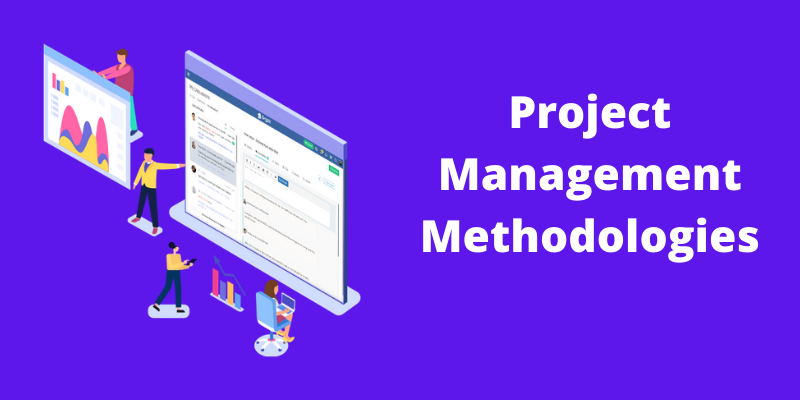Hello!
A project management methodology is a framework that is used to organize and optimize business projects. With a constantly growing number of methodologies to choose from, selecting the right one for you can feel a bit overwhelming. To make it easier for you, we’ve identified the top 8 methods for managing projects in your business.
Top Methodologies
Critical Path
 The critical path method is a great option for complicated tasks that are made up of dependent smaller tasks. Essentially, this system allows you to lay out all the steps you need to take to complete the overall project in the order of when those steps need to take place. This allows you to see the “critical path” of steps you need to take to achieve the end goal. One software that offers this project method is the Gantt chart project timeline, which you can find at GanttPRO.com.
The critical path method is a great option for complicated tasks that are made up of dependent smaller tasks. Essentially, this system allows you to lay out all the steps you need to take to complete the overall project in the order of when those steps need to take place. This allows you to see the “critical path” of steps you need to take to achieve the end goal. One software that offers this project method is the Gantt chart project timeline, which you can find at GanttPRO.com.
Pros
- Works well for large-scale projects with many steps
- Allows you to visually see the path to project completion
- Is effective when there are a lot of steps that rely on the completion of other tasks
- Allows you to set strict deadlines
Cons
- Can be unnecessarily complicated for simple projects.
- Isn’t as effective for projects with flexible deadlines.
Waterfall
 The Waterfall method is a more traditional approach to managing projects. Like a waterfall in nature, task completion only flows in one direction, meaning that each phase in the process must be completed before the next can begin and you can’t return to previous phases once you’ve moved on. Waterfall is a very simple and straightforward methodology to use.
The Waterfall method is a more traditional approach to managing projects. Like a waterfall in nature, task completion only flows in one direction, meaning that each phase in the process must be completed before the next can begin and you can’t return to previous phases once you’ve moved on. Waterfall is a very simple and straightforward methodology to use.
Pros
- Works well for small-scale projects with a clear order of operations
- Great for industries that have a structured and unchanging approach to projects
- Enables you to add new employees to the project and get them up to speed quickly
- Prioritizes documentation of each step
Cons
- Does not allow for changes to the project once the plan is created
- Is not forgiving when mistakes are made
Agile
 Unlike the previous two project management methods, Agile was designed with flexibility in mind. This method organizes tasks into “sprints” and involves getting feedback on the product after each sprint. This shortens the time it takes for customers to see the product because they see and approve features throughout the creation process.
Unlike the previous two project management methods, Agile was designed with flexibility in mind. This method organizes tasks into “sprints” and involves getting feedback on the product after each sprint. This shortens the time it takes for customers to see the product because they see and approve features throughout the creation process.
Pros
- Increases customer satisfaction by shortening response time
- Works well for small teams that collaborate on a single project
- Incorporates feedback throughout the course of the project
Cons
- Leaves the end date of the project fairly open
- Can leave customers feeling less satisfied due to seeing the product before completion
Hybrid
The hybrid method combines Agile and Waterfall methodologies. This strategy involves clear planning and goals while allowing for flexibility in phase completion, which enables teams to know what to expect going forward but allows wiggle room so they can make changes along the way.
Pros
- Gives teams a clear and detailed overview of the project
- Allows for changes and adjustments to the plan
- Helps teams stay on track while incorporating feedback into product creation
Cons
- Not as flexible as the Agile method
Lean
 The Lean method focuses on maximizing value for customers and minimizing wasted time, effort, spending, and resources. This process involves 3Ms: Muda (wastefulness), Mura (unevenness), and Muri (overburden).
The Lean method focuses on maximizing value for customers and minimizing wasted time, effort, spending, and resources. This process involves 3Ms: Muda (wastefulness), Mura (unevenness), and Muri (overburden).
- Muda: waste of resources without adding value to customers
- Mura: inefficient processes that lead to unevenness in production
- Muri: unnecessary strain on workers and equipment that causes breakdowns
Pros
- Helps optimize production and improve company functioning
- Adds value to customers while reducing the company costs
Cons
- Can be costly to invest in Lean project management
- May lead to problems in inventory
Scrum
 The Scrum method was designed for continuous projects. Like the Agile approach, large projects are divided into “sprints”; however, Scrum divides the tasks down further by delegating tasks to each team member. After each “sprint”, the team meets to discuss their performance and make changes before the next phase.
The Scrum method was designed for continuous projects. Like the Agile approach, large projects are divided into “sprints”; however, Scrum divides the tasks down further by delegating tasks to each team member. After each “sprint”, the team meets to discuss their performance and make changes before the next phase.
Pros
- Helps ensure continuous team development
- Works well for tasks that are more easily completed independently
Cons
- Requires regular meetings that can feel unnecessary
- Doesn’t work well for projects that depend on collaboration
Kanban
The Kanban method lays tasks out into columns such as “Not Started”, “In Progress”, and “Complete”. This allows teams to visually track their progress by seeing which stage each task is in.
Pros
- Offers an easy way to visualize task completion
- Tracks many tasks at one time
Cons
- Doesn’t work for complex projects with an abundance of stages
- Can be overwhelming to look at
Scrumban
The Scrumban method is a combination of the Scrum method and the Kanban method. This methodology involves dividing tasks up among team members, but the team members pull tasks from the backlog which is laid out in a Kanban board. This layout allows for fewer meetings because members can clearly see the team’s progress.
Pros
- Requires fewer meetings than the Scrum method
- Teams can visually see their project progress
Cons
- There are less defined parameters which can lead to problems
How Do You Choose the Right Project Management Methodology for Your Business?
 Now that you know the top 8 methods for managing projects, you may still need help picking the best one for you and your business. Here are 5 things you should consider:
Now that you know the top 8 methods for managing projects, you may still need help picking the best one for you and your business. Here are 5 things you should consider:
- Size of Your Team – Each methodology supports a different size team. You should consider how many people you have working on each project and the needs of the team in terms of delegation and organization.
- Amount of Collaboration You Desire – Some processes are more collaboration-focused while others delegate tasks to individual members.
- Flexibility of Your Projects – Think about whether your projects need flexibility or have strict phases.
- Budget – You should know how much you can realistically spend on management software to narrow your options.
- Timeline of Your Projects – Consider whether you have strict deadlines or relatively flexible deadlines.
Also read:
- The Adobe Acrobat Killer: Stirling PDF Now Open Source
- Freelancers in Iran: The Potential of Using Cryptocurrencies via Quasa Connect Introduction
- Growth Hacking 101
Conclusion
Finding the best way to manage projects for your business is key to ensuring projects are completed correctly and on time. Use one of these top methodologies to level up your company’s productivity.
Thank you!
Join us on social media!
See you!






